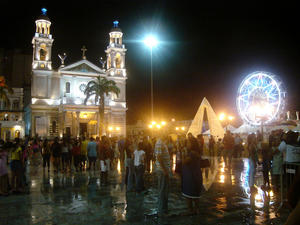 Basilica Santuario de Nazaré - MAP 6
In 1700, the place where he found the image of the Virgin of Nazareth, 28 cm, the Caboclo José Placido built a hut, soon turned into a center of devotion, which is now the Basilica Shrine of Nazareth. This is one of the most beautiful places of worship in Brazil. It features an all-marble interior where you find the image of Our Lady. Nazareth found by Placido. Its interior features a collection of 23 Mosaics d... Basilica Santuario de Nazaré - MAP 6
In 1700, the place where he found the image of the Virgin of Nazareth, 28 cm, the Caboclo José Placido built a hut, soon turned into a center of devotion, which is now the Basilica Shrine of Nazareth. This is one of the most beautiful places of worship in Brazil. It features an all-marble interior where you find the image of Our Lady. Nazareth found by Placido. Its interior features a collection of 23 Mosaics d... |
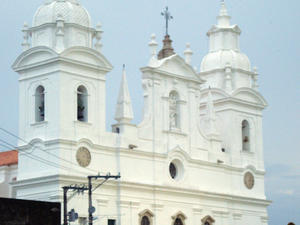 Belem Cathedral - MAP 6
A colonial landmark with strong neoclassical and baroque influences, the Catedral da Sé stands on the Praca Frei Brandão, next to Padre Champagnat and close to the waterfront.
Construction began in 1748 and this cathedral was completed just under 25 years later, in 1771.
Particularly notable are the twin towers, the bright white facade a... Belem Cathedral - MAP 6
A colonial landmark with strong neoclassical and baroque influences, the Catedral da Sé stands on the Praca Frei Brandão, next to Padre Champagnat and close to the waterfront.
Construction began in 1748 and this cathedral was completed just under 25 years later, in 1771.
Particularly notable are the twin towers, the bright white facade a... |
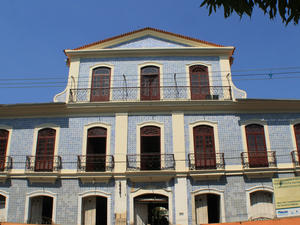 Historical and Geographical Institute of Para - MAP 3
In the old street Tomázia Perdigão No. 62, D'aveiro current Sister City, the Old Town district, located at Praça Dom Pedro II, formerly the Palace Square, Constitution Square, and the Independence Square, there is the impressive Solar Viscount and Baron Arary Guajará, seat-of IHGP own.
Architectural construction of the first half of the nineteenth century, characterized by neo-classical ... Historical and Geographical Institute of Para - MAP 3
In the old street Tomázia Perdigão No. 62, D'aveiro current Sister City, the Old Town district, located at Praça Dom Pedro II, formerly the Palace Square, Constitution Square, and the Independence Square, there is the impressive Solar Viscount and Baron Arary Guajará, seat-of IHGP own.
Architectural construction of the first half of the nineteenth century, characterized by neo-classical ... |
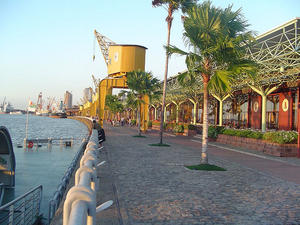 Our Lady of Nazareth Shrine - MAP 6
Basilica de Nazare is a church built in 1852. It is a replica of San Paolo fuori le Mura, a church in Rome. It is draped in gold as well as Carrara marble.
Cathedral It is one of Brazil's beautiful churches. It was built in 1748.
The Basilica in the neighborhood of Nazareth, located in Belém, the church was built by priests Barnabites at the beginning of the twentieth centur... Our Lady of Nazareth Shrine - MAP 6
Basilica de Nazare is a church built in 1852. It is a replica of San Paolo fuori le Mura, a church in Rome. It is draped in gold as well as Carrara marble.
Cathedral It is one of Brazil's beautiful churches. It was built in 1748.
The Basilica in the neighborhood of Nazareth, located in Belém, the church was built by priests Barnabites at the beginning of the twentieth centur... |
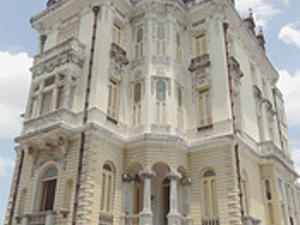 Palacete Bolonha - MAP 3 One of the icons of the era buildings that Para was rich, perhaps the building that most represents the urban context of the Bethlehem is the beginning of this century palace Bologna. One of the most beautiful architectural buildings built in the XIX century and beginning of XX century, 1870-1912, Bethlehem went through a process of modernization and expansion of its urban area, a period called "rubber boom", the palace Bologna was and ... Palacete Bolonha - MAP 3 One of the icons of the era buildings that Para was rich, perhaps the building that most represents the urban context of the Bethlehem is the beginning of this century palace Bologna. One of the most beautiful architectural buildings built in the XIX century and beginning of XX century, 1870-1912, Bethlehem went through a process of modernization and expansion of its urban area, a period called "rubber boom", the palace Bologna was and ... |
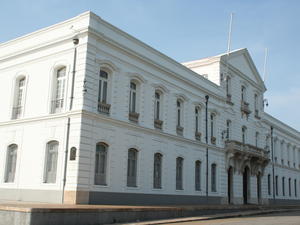 Palacio Lauro Sodré - MAP 3
Lauro Sodré Palace, home of the Museum of Pará in 1994, is an imposing neoclassical building, built according to plans by the Italian architect Antonio Landi, the eighteenth century. It was erected as the seat of state government and, concomitantly, to house the General Governor of the Province and his family. Among the many reforms, adaptations and / or additions by now, was crucial to the governor empreendi... Palacio Lauro Sodré - MAP 3
Lauro Sodré Palace, home of the Museum of Pará in 1994, is an imposing neoclassical building, built according to plans by the Italian architect Antonio Landi, the eighteenth century. It was erected as the seat of state government and, concomitantly, to house the General Governor of the Province and his family. Among the many reforms, adaptations and / or additions by now, was crucial to the governor empreendi... |
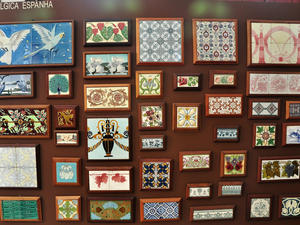 Pinho Palace - MAP 6 The Palacete Pinho is considered by the Institute of Historical and Artistic Heritage (Iphan) as one of the most characteristic examples that marked the late nineteenth century, the coming economic summit of the boom.Since the beginning of its occupation by the family of Antonio José de Pinho Commander, responsible for its construction, was the scene of constant cultural events. Adopting a common architectural advantage in Portugal in ... Pinho Palace - MAP 6 The Palacete Pinho is considered by the Institute of Historical and Artistic Heritage (Iphan) as one of the most characteristic examples that marked the late nineteenth century, the coming economic summit of the boom.Since the beginning of its occupation by the family of Antonio José de Pinho Commander, responsible for its construction, was the scene of constant cultural events. Adopting a common architectural advantage in Portugal in ... |
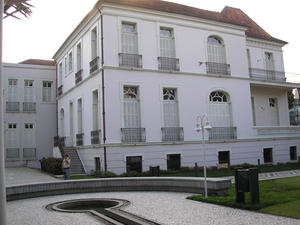 Residencia Park - MAP 3
Park's Residence
Located on the Avenida Governador Magalhaes Barata, the Parque da Residencia has served as the official residence of the state governor since 1934, although governors have actually used this building from 1913 onwards. Currently, the Residence operates as the headquarters for Pará's Secretariat of Culture (SECULT). Many attractions are close by and include the Passagem das Icamiabas, an amphitheat... Residencia Park - MAP 3
Park's Residence
Located on the Avenida Governador Magalhaes Barata, the Parque da Residencia has served as the official residence of the state governor since 1934, although governors have actually used this building from 1913 onwards. Currently, the Residence operates as the headquarters for Pará's Secretariat of Culture (SECULT). Many attractions are close by and include the Passagem das Icamiabas, an amphitheat... |
 Basilica Santuario de Nazaré - MAP 6
In 1700, the place where he found the image of the Virgin of Nazareth, 28 cm, the Caboclo José Placido built a hut, soon turned into a center of devotion, which is now the Basilica Shrine of Nazareth. This is one of the most beautiful places of worship in Brazil. It features an all-marble interior where you find the image of Our Lady. Nazareth found by Placido. Its interior features a collection of 23 Mosaics d...
Basilica Santuario de Nazaré - MAP 6
In 1700, the place where he found the image of the Virgin of Nazareth, 28 cm, the Caboclo José Placido built a hut, soon turned into a center of devotion, which is now the Basilica Shrine of Nazareth. This is one of the most beautiful places of worship in Brazil. It features an all-marble interior where you find the image of Our Lady. Nazareth found by Placido. Its interior features a collection of 23 Mosaics d... Belem Cathedral - MAP 6
A colonial landmark with strong neoclassical and baroque influences, the Catedral da Sé stands on the Praca Frei Brandão, next to Padre Champagnat and close to the waterfront.
Construction began in 1748 and this cathedral was completed just under 25 years later, in 1771.
Particularly notable are the twin towers, the bright white facade a...
Belem Cathedral - MAP 6
A colonial landmark with strong neoclassical and baroque influences, the Catedral da Sé stands on the Praca Frei Brandão, next to Padre Champagnat and close to the waterfront.
Construction began in 1748 and this cathedral was completed just under 25 years later, in 1771.
Particularly notable are the twin towers, the bright white facade a... Historical and Geographical Institute of Para - MAP 3
In the old street Tomázia Perdigão No. 62, D'aveiro current Sister City, the Old Town district, located at Praça Dom Pedro II, formerly the Palace Square, Constitution Square, and the Independence Square, there is the impressive Solar Viscount and Baron Arary Guajará, seat-of IHGP own.
Architectural construction of the first half of the nineteenth century, characterized by neo-classical ...
Historical and Geographical Institute of Para - MAP 3
In the old street Tomázia Perdigão No. 62, D'aveiro current Sister City, the Old Town district, located at Praça Dom Pedro II, formerly the Palace Square, Constitution Square, and the Independence Square, there is the impressive Solar Viscount and Baron Arary Guajará, seat-of IHGP own.
Architectural construction of the first half of the nineteenth century, characterized by neo-classical ... Our Lady of Nazareth Shrine - MAP 6
Basilica de Nazare is a church built in 1852. It is a replica of San Paolo fuori le Mura, a church in Rome. It is draped in gold as well as Carrara marble.
Cathedral It is one of Brazil's beautiful churches. It was built in 1748.
The Basilica in the neighborhood of Nazareth, located in Belém, the church was built by priests Barnabites at the beginning of the twentieth centur...
Our Lady of Nazareth Shrine - MAP 6
Basilica de Nazare is a church built in 1852. It is a replica of San Paolo fuori le Mura, a church in Rome. It is draped in gold as well as Carrara marble.
Cathedral It is one of Brazil's beautiful churches. It was built in 1748.
The Basilica in the neighborhood of Nazareth, located in Belém, the church was built by priests Barnabites at the beginning of the twentieth centur... Palacete Bolonha - MAP 3 One of the icons of the era buildings that Para was rich, perhaps the building that most represents the urban context of the Bethlehem is the beginning of this century palace Bologna. One of the most beautiful architectural buildings built in the XIX century and beginning of XX century, 1870-1912, Bethlehem went through a process of modernization and expansion of its urban area, a period called "rubber boom", the palace Bologna was and ...
Palacete Bolonha - MAP 3 One of the icons of the era buildings that Para was rich, perhaps the building that most represents the urban context of the Bethlehem is the beginning of this century palace Bologna. One of the most beautiful architectural buildings built in the XIX century and beginning of XX century, 1870-1912, Bethlehem went through a process of modernization and expansion of its urban area, a period called "rubber boom", the palace Bologna was and ... Palacio Lauro Sodré - MAP 3
Lauro Sodré Palace, home of the Museum of Pará in 1994, is an imposing neoclassical building, built according to plans by the Italian architect Antonio Landi, the eighteenth century. It was erected as the seat of state government and, concomitantly, to house the General Governor of the Province and his family. Among the many reforms, adaptations and / or additions by now, was crucial to the governor empreendi...
Palacio Lauro Sodré - MAP 3
Lauro Sodré Palace, home of the Museum of Pará in 1994, is an imposing neoclassical building, built according to plans by the Italian architect Antonio Landi, the eighteenth century. It was erected as the seat of state government and, concomitantly, to house the General Governor of the Province and his family. Among the many reforms, adaptations and / or additions by now, was crucial to the governor empreendi... Pinho Palace - MAP 6 The Palacete Pinho is considered by the Institute of Historical and Artistic Heritage (Iphan) as one of the most characteristic examples that marked the late nineteenth century, the coming economic summit of the boom.Since the beginning of its occupation by the family of Antonio José de Pinho Commander, responsible for its construction, was the scene of constant cultural events. Adopting a common architectural advantage in Portugal in ...
Pinho Palace - MAP 6 The Palacete Pinho is considered by the Institute of Historical and Artistic Heritage (Iphan) as one of the most characteristic examples that marked the late nineteenth century, the coming economic summit of the boom.Since the beginning of its occupation by the family of Antonio José de Pinho Commander, responsible for its construction, was the scene of constant cultural events. Adopting a common architectural advantage in Portugal in ... Residencia Park - MAP 3
Park's Residence
Located on the Avenida Governador Magalhaes Barata, the Parque da Residencia has served as the official residence of the state governor since 1934, although governors have actually used this building from 1913 onwards. Currently, the Residence operates as the headquarters for Pará's Secretariat of Culture (SECULT). Many attractions are close by and include the Passagem das Icamiabas, an amphitheat...
Residencia Park - MAP 3
Park's Residence
Located on the Avenida Governador Magalhaes Barata, the Parque da Residencia has served as the official residence of the state governor since 1934, although governors have actually used this building from 1913 onwards. Currently, the Residence operates as the headquarters for Pará's Secretariat of Culture (SECULT). Many attractions are close by and include the Passagem das Icamiabas, an amphitheat...